Strangers No More, by Richard Alba and Nancy Foner
While I was writing this review, Pope Francis denounced the exploitation of migrant workers in a “throwaway economy”; Great Britain sought to curtail illegal entry through the Channel Tunnel; and Donald Trump, calling the United States “a dumping ground for everyone else’s problems,” vowed to build “a great wall” along the Mexican border if he is elected president. The timeliness of Strangers No More is indisputable. The strangers of the title are mainly low-status immigrants and their children: Mexicans in the United States, “visible minorities” in Canada, Pakistanis in Great Britain, North Africans in France, Surinamese in the Netherlands, and Turks in Germany—all of whom experience marginal membership in their host societies.
Readers can expect much from this book, but they should not expect too much. Richard Alba and Nancy Foner, seasoned sociologists from the City University of New York, know the limitations of their data, which at times cannot support a conclusion, and at other times can support only a qualified one. Questions like “Which country is most successful in integrating its immigrant population?” have no simple answers. There are too many variables for researchers to make such broad determinations, and thus “there are no clear-cut winners or losers: each society fails and succeeds in different ways.”
The authors do not shy away from identifying specific failures; for instance, the situation of undocumented immigrants in the United States is a “scandal.” Still, reality is complicated, and given the methodological constraints of sociological analysis, this may be one of the most important conclusions of Strangers No More.






